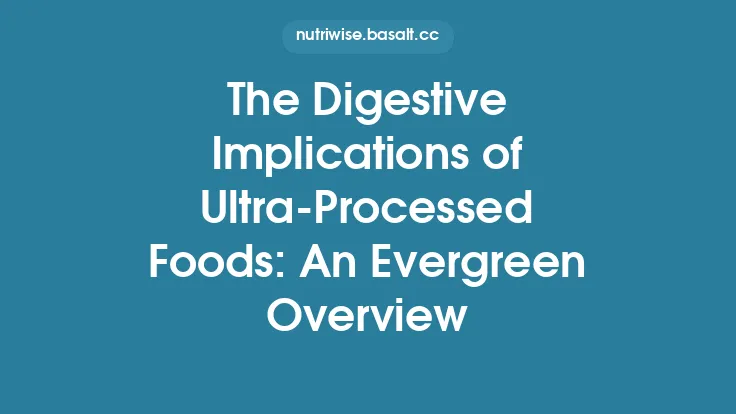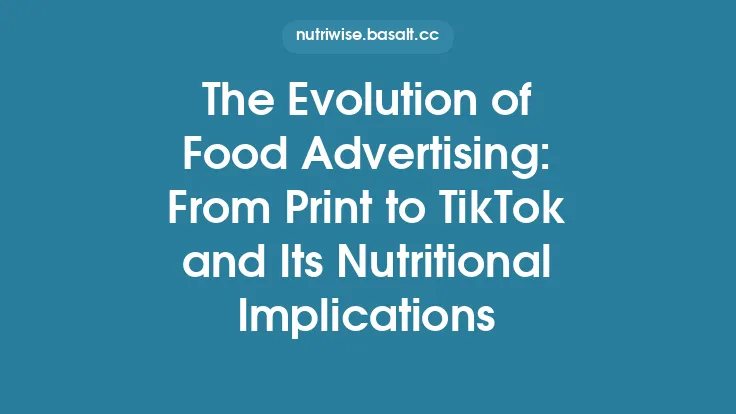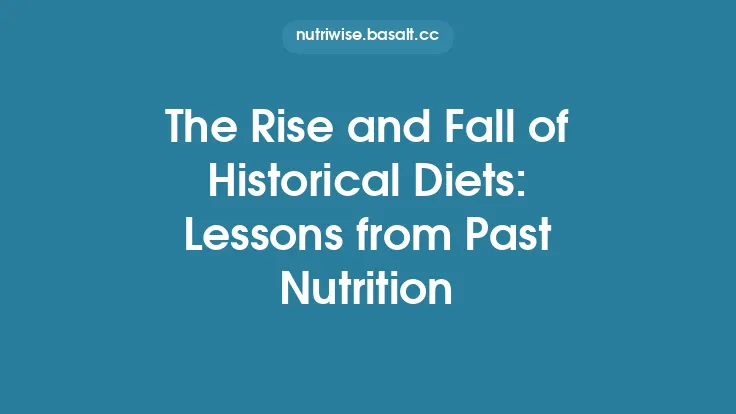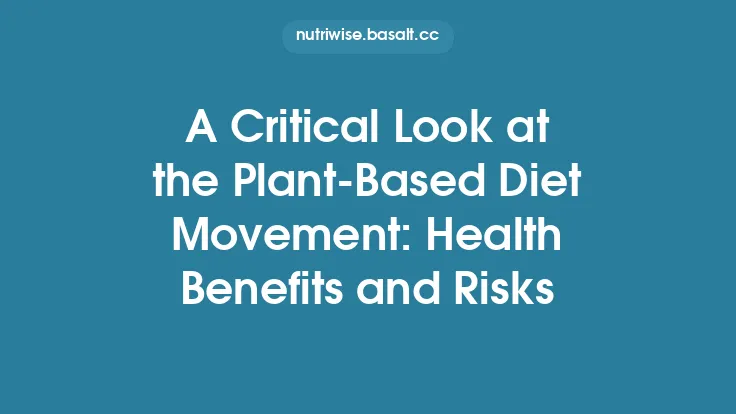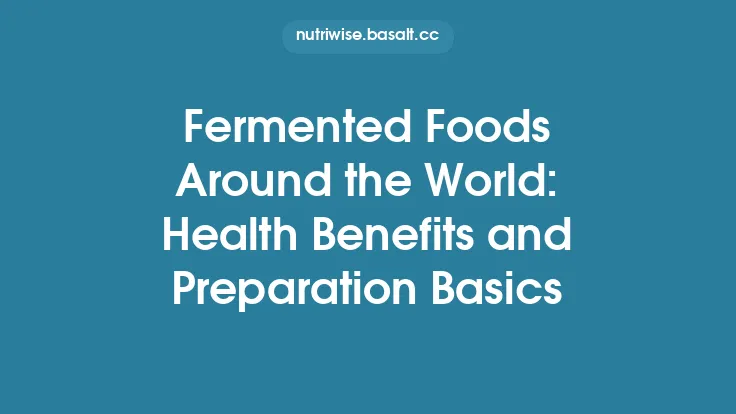The consumption of ultra‑processed foods (UPFs) has escalated dramatically over the past few decades, reshaping dietary landscapes worldwide. While the convenience, palatability, and aggressive marketing of these products have driven their popularity, a growing body of epidemiologic research points to a constellation of adverse health outcomes associated with high UPF intake. This article synthesizes current knowledge on the epidemiology of ultra‑processed foods, explores the mechanisms that may underlie their health impacts, and outlines emerging strategies for surveillance and intervention.
Defining Ultra‑Processed Foods: The NOVA Classification
The term “ultra‑processed” originates from the NOVA food‑processing classification system, which categorizes foods into four groups based on the extent and purpose of industrial processing:
- Unprocessed or minimally processed foods – edible parts of plants or animals that have undergone basic procedures such as cleaning, removal of inedible parts, or simple preservation (e.g., fresh fruit, raw meat).
- Processed culinary ingredients – substances extracted from group 1 foods or nature (e.g., oils, sugar, salt) used to prepare dishes.
- Processed foods – relatively simple products made by adding group 2 ingredients to group 1 foods (e.g., canned vegetables, cheese, freshly baked bread).
- Ultra‑processed foods – formulations predominantly of industrial ingredients and additives, created through multiple processing steps, and designed to be hyper‑palatable, shelf‑stable, and ready‑to‑consume (e.g., soft drinks, packaged snacks, reconstituted meat analogues, instant noodles, confectionery).
UPFs are distinguished not merely by the presence of added sugars, fats, or salts, but by the extensive use of food‑grade additives (emulsifiers, flavor enhancers, colorants), novel ingredients (hydrolyzed proteins, modified starches), and processing techniques (extrusion, high‑pressure treatment, spray‑drying) that fundamentally alter the food matrix.
Global Consumption Patterns and Temporal Trends
Large‑scale dietary surveys and market‑share analyses have documented a steady rise in the proportion of total energy derived from UPFs across continents. In high‑income nations, UPFs now contribute 50–60 % of daily caloric intake, whereas middle‑income countries report rapid increases from 10–15 % a decade ago to 30 % or more today. Key observations include:
- Age‑related gradients: Adolescents and young adults consistently exhibit the highest UPF consumption, reflecting both lifestyle preferences and targeted advertising.
- Socio‑economic differentials: In many settings, lower‑income households rely more heavily on inexpensive, energy‑dense UPFs, whereas higher‑income groups may incorporate them alongside fresh foods.
- Urban versus rural contrast: Urban environments, with greater retail density of supermarkets and convenience stores, show higher UPF penetration compared with rural areas where traditional food preparation persists.
These patterns are corroborated by longitudinal data from national nutrition monitoring programs, which reveal a clear upward trajectory in UPF share of total diet over the past 20–30 years, independent of overall caloric intake.
Determinants of the Ultra‑Processed Food Surge
Multiple interlocking forces have propelled the expansion of UPFs:
- Industrial consolidation and supply‑chain efficiency – Global food conglomerates leverage economies of scale to produce standardized, shelf‑stable products at low cost.
- Technological innovation – Advances in food engineering (e.g., extrusion, micro‑encapsulation) enable the creation of novel textures and flavors that mimic whole‑food experiences.
- Retail and distribution dynamics – Super‑size packaging, strategic shelf placement, and omnichannel marketing (online, mobile apps) increase product visibility and impulse purchase rates.
- Policy and regulatory environments – In many jurisdictions, limited restrictions on marketing, labeling, and taxation of UPFs facilitate their market dominance.
- Sociocultural shifts – Time scarcity, dual‑income households, and the rise of “on‑the‑go” lifestyles elevate demand for ready‑to‑eat options.
Understanding these drivers is essential for designing interventions that address the root causes of UPF overconsumption rather than merely its symptoms.
Epidemiologic Evidence Linking Ultra‑Processed Foods to Health Outcomes
A growing corpus of prospective cohort studies, case‑control investigations, and meta‑analyses has examined the relationship between UPF intake and a spectrum of health endpoints. While causality cannot be definitively established from observational data alone, the consistency of associations across diverse populations strengthens the inference of a detrimental effect.
Cardiometabolic Health
- Incidence of hypertension: High UPF consumption (≥ 30 % of total energy) is associated with a 20–30 % increased risk of developing elevated blood pressure, independent of total sodium intake.
- Type 2 diabetes: Cohorts in Europe and North America report hazard ratios of 1.3–1.5 for incident diabetes among participants in the highest quintile of UPF intake, after adjusting for BMI, physical activity, and socioeconomic status.
- Dyslipidemia: Elevated triglycerides and reduced HDL‑cholesterol have been linked to diets rich in UPFs, likely reflecting the high proportion of refined carbohydrates and industrial trans‑fatty acids.
Oncologic Risks
Large pooled analyses have identified modest but statistically significant associations between UPF consumption and certain cancers, notably colorectal and breast cancer. Proposed mechanisms include exposure to food‑borne contaminants (e.g., acrylamide, heterocyclic amines) generated during high‑temperature processing, as well as chronic low‑grade inflammation driven by dietary additives.
Gut Microbiome Alterations
Cross‑sectional studies employing 16S rRNA sequencing reveal that individuals with high UPF diets exhibit reduced microbial diversity and a shift toward taxa associated with metabolic endotoxemia (e.g., increased *Enterobacteriaceae*). Experimental feeding trials in rodents demonstrate that emulsifiers commonly used in UPFs can disrupt the mucosal barrier, fostering dysbiosis and metabolic disturbances.
Neurobehavioral and Mental Health Implications
Emerging evidence suggests a link between UPF intake and adverse mental health outcomes. Prospective data indicate that higher UPF consumption predicts greater odds of depressive symptoms and poorer cognitive performance, potentially mediated by inflammatory pathways and altered gut‑brain signaling.
Potential Biological Mechanisms
The health effects of UPFs are likely multifactorial, encompassing:
- Nutrient profile imbalances – UPFs are typically energy‑dense, low in fiber, micronutrients, and phytochemicals, while being high in refined carbohydrates, added fats, and sugars.
- Additive‑induced perturbations – Emulsifiers, artificial sweeteners, and flavor enhancers may interfere with gut barrier integrity, alter microbial composition, and modulate satiety signaling.
- Processing‑derived contaminants – High‑temperature processes generate advanced glycation end‑products (AGEs), acrylamide, and polycyclic aromatic hydrocarbons, all of which have pro‑inflammatory and genotoxic properties.
- Hyper‑palatability and reward circuitry – The combination of taste modifiers and rapid digestion leads to heightened dopamine release, promoting over‑consumption and reinforcing habitual intake.
- Altered food matrix – Disruption of the natural food structure reduces the physical satiety cues provided by whole foods, leading to faster gastric emptying and reduced post‑prandial satiety.
Methodological Considerations in Ultra‑Processed Food Research
Accurately quantifying UPF intake poses several challenges:
- Food composition databases – Many national nutrient tables lack classification of foods according to processing level, necessitating the development of bespoke UPF‑specific databases.
- Recall bias and misclassification – Self‑reported dietary assessments may under‑report UPF consumption, especially when participants are unaware of processing categories.
- Confounding by lifestyle factors – UPF intake often co‑varies with physical inactivity, smoking, and other health‑related behaviors, requiring rigorous multivariable adjustment.
- Temporal changes in product formulation – Reformulation of existing products (e.g., reduction of trans‑fat) can alter their health impact over time, complicating longitudinal analyses.
Addressing these methodological issues is critical for generating robust evidence that can inform policy.
Public Health and Policy Responses
Given the mounting epidemiologic data, several jurisdictions have begun to implement strategies aimed at curbing UPF consumption:
- Fiscal measures – Excise taxes on sugar‑sweetened beverages and certain snack categories have demonstrated modest reductions in sales and consumption.
- Front‑of‑pack labeling – Warning symbols or nutrient‑profile scores that highlight high levels of added sugars, fats, or sodium can steer consumers toward less processed options.
- Marketing restrictions – Limiting advertising of UPFs to children, particularly during peak viewing hours, reduces early exposure and preference formation.
- School and workplace procurement policies – Mandating the provision of minimally processed meals in institutional settings has shown improvements in dietary quality among participants.
- Public education campaigns – Nutrition literacy programs that teach the NOVA classification empower individuals to make informed choices.
These interventions, when combined with broader food system reforms, hold promise for attenuating the health burden associated with ultra‑processed diets.
Future Directions and Research Gaps
To deepen our understanding and guide effective action, several research avenues merit attention:
- Longitudinal intervention trials – Randomized controlled feeding studies that replace UPFs with minimally processed alternatives can elucidate causal pathways.
- Molecular phenotyping – Integrating metabolomics, proteomics, and epigenomics with dietary data may uncover biomarkers of UPF exposure and early disease risk.
- Life‑course perspectives – Investigating UPF impacts from prenatal exposure through older adulthood will clarify critical windows of susceptibility.
- Equity‑focused analyses – Disentangling how socioeconomic, cultural, and geographic factors intersect with UPF consumption can inform targeted policies.
- Digital surveillance – Leveraging point‑of‑sale data, mobile food‑logging apps, and machine‑learning classification of product images can enhance real‑time monitoring of UPF trends.
Conclusion
Ultra‑processed foods have become a dominant component of modern diets, driven by industrial innovation, market forces, and shifting consumer lifestyles. A robust and growing body of epidemiologic evidence links high UPF intake to a range of adverse health outcomes, including cardiometabolic disease, certain cancers, gut dysbiosis, and mental health disturbances. While observational studies cannot prove causality, the consistency of findings across populations, coupled with plausible biological mechanisms, underscores the urgency of addressing this dietary shift. Multifaceted public‑health strategies—encompassing fiscal policies, labeling reforms, marketing restrictions, and education—are essential to mitigate the health risks posed by ultra‑processed foods. Continued investment in high‑quality research, especially intervention trials and advanced phenotyping, will be pivotal for translating epidemiologic insights into effective, equitable nutrition policies.
